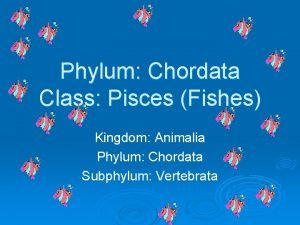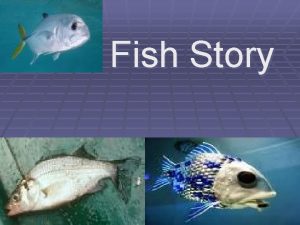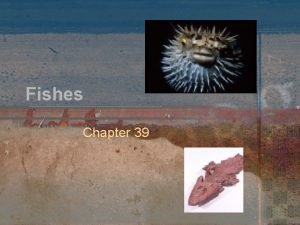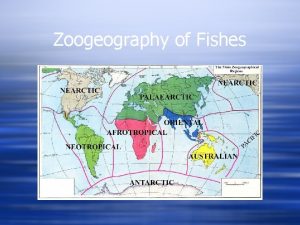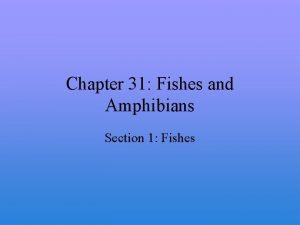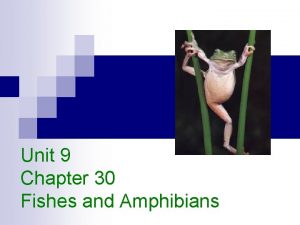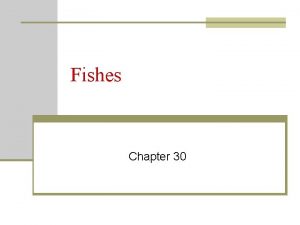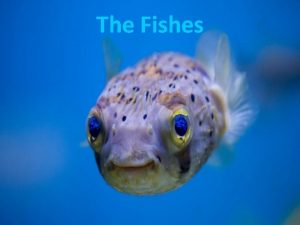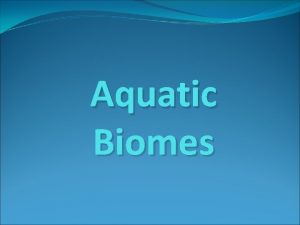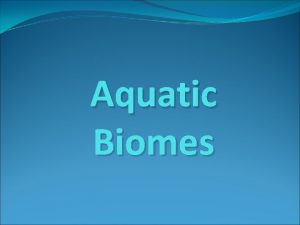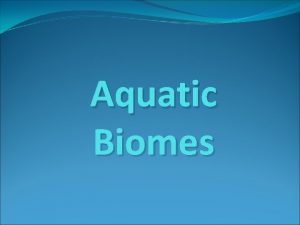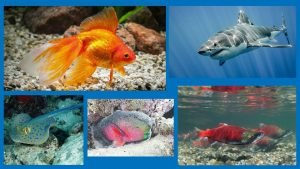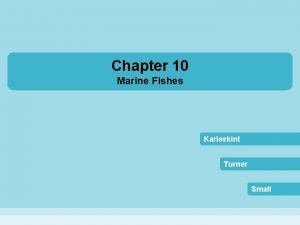Fishes What Is a Fish Fish are aquatic
















- Slides: 16

Fishes

What Is a Fish? Fish are aquatic vertebrates and most have paired fins, scales, and gills. Fins are used for movement Scales are used for protection Gills are used for gas exchange

Form and Function in Fishes Fish feed in all different ways – herbivores, carnivores, parasites, filter feeders, and detritus feeders. Fish have pouches called pyloric ceca – this secretes digestive enzymes and absorbs nutrients from digested food. They also have a liver and pancreas that help break down food.

Respiration Most fish use gills. Gill are made of filaments – feathery, threadlike structures. Each filament has many capillaries that provide a lot of area for exchange oxygen and carbon dioxide. Lampreys and sharks have several gill openings. Most fish only have a single opening on each side of the body. There are fish that have specialized organs that act as lungs. These fish live in areas with oxygen-poor water or in areas where the water dries up.

Circulation Fishes have closed circulatory system. The heart pumps blood in a single loop from the heart to the gills, from the gills to the rest of the body, and back to the heart. The heart has 4 parts: sinus venosus, atrium, ventricle, and bulbus arteriosus. An atrium is a large chamber that stores blood that is about to enter the ventricle. The ventricle is the actual pumping part of the heart.

Excretion Fish will get rid of nitrogenous wastes in the form of ammonia. Some waste will diffuse through the gills. Fishes have kidneys to help control the amount of water in their bodies. Fishes in salt water lose water by osmosis so the kidneys help give back as much water as possible. In fresh water fishes excess water is pumped out.

Response Fishes have a well developed nervous system with a brain. Fishes brain are complex. They have a cerebrum – this area is responsible for all voluntary activities of the body. The cerebellum coordinates body movements. The medulla oblongata controls the functions of internal organs.

Many fish have well developed eyes. They also have chemoreceptors that are responsible for taste and smell. They have a lateral line system that detects gentle currents and vibrations in the water. They can sense the movement of nearby fishes or prey swimming close by.

Movement Most fish move with the help of paired muscles. Fish have a streamlined shape that allows them to move through water without drag (friction). Many fish have a swim bladder – this allows them to float or adjust so they can move up and down in the water column.

Reproduction Different species fertilize eggs either internally or externally. Many fish the female will lay the eggs and the eggs will be fertilized and develop outside the body. Fish that reproduce this way are called oviparous. Ovoviviparous eggs will stay in the mother’s body after internal fertilization. The offspring will live off the yolk of the eggs and not the mother. Viviparous is when internal fertilization takes place but the young gets things to live from the mother directly.

Groups of Fishes 24, 000 species of fish. Grouped according to body structure. 3 groups - jawless fish, cartilaginous fish, and bony fish.

Jawless Fish Jawless fish have no true teeth or jaws. They have skeletons make of fibers and cartilage. Lampreys are filter feeders as larvae and parasites as adults. Adult lampreys will attach to fishes and sometimes whales or dolphins where they will scrape away skin and suck up the tissue and body fluid of its host. Hagfish have pinkish gray, wormlike bodies and tentacles. They do not have eyes. They excrete large amounts of slime. They have an open circulatory system.

Sharks, Rays, and Skates They have a skeleton make of cartilage. They also have toothlike scales covering their skin. Most sharks have curved tails and pointed noses. They have a large number of teeth. The teeth in the front row get lost or worn out and are continually replaced. Not all sharks have large teeth. There are sharks that filter feed.

Skates and rays vary in what they feed on. When not feeding or swimming many skates and rays will cover themselves with a thin layer of sand rest on the ocean floor.

Bony Fishes The skeletons of these fish are made of bone. Most of the living bony fishes are in the group of ray-finned fishes. These fish have slender bony spines that are connected by a thin layer of skin to make fins. There are lobe finned fishes. Lungfish live in fresh water. Coelacanth lives in salt water.

Ecology of Fishes Most fish have to stay either in salt water or fresh water, they cannot switch back and forth. Lampreys, sturgenons, and salmon spend most of their lives in the ocean but migrate to fresh water to breed. These are called anadromous. Catadromous fish live most of their life in freshwater and go to salt water to breed. Example would be European eels.
 Mikael ferm
Mikael ferm One fish two fish red fish blue fish ride
One fish two fish red fish blue fish ride The fishes vertebrate success in water
The fishes vertebrate success in water Characteristics of fish
Characteristics of fish One fish, two fish, blowfish, blue fish
One fish, two fish, blowfish, blue fish Phylum pisces
Phylum pisces I love the fishes japanese
I love the fishes japanese Concept mapping chapter 28 fishes and amphibians
Concept mapping chapter 28 fishes and amphibians Section 39-3 review bony fishes
Section 39-3 review bony fishes Zoogeography of fishes
Zoogeography of fishes Bipedal
Bipedal Scheherazade allusion
Scheherazade allusion Chapter 31 fishes and amphibians answer key
Chapter 31 fishes and amphibians answer key Area opaca and area pellucida
Area opaca and area pellucida Chapter 30 fishes and amphibians worksheet answers
Chapter 30 fishes and amphibians worksheet answers Scombridae
Scombridae Study of fishes
Study of fishes





